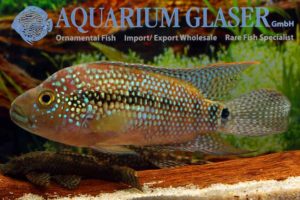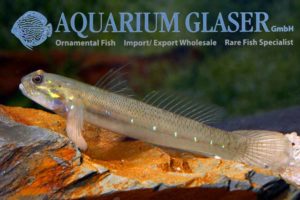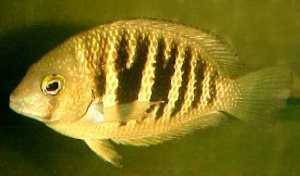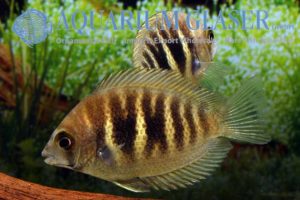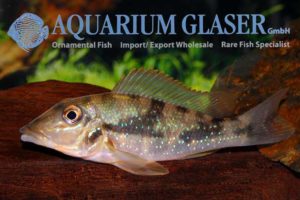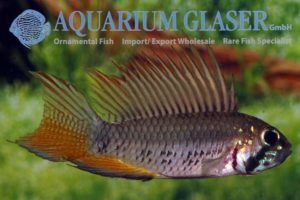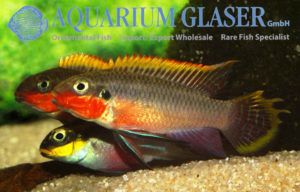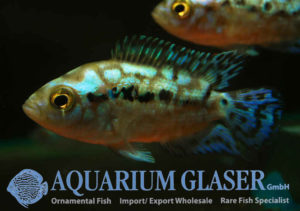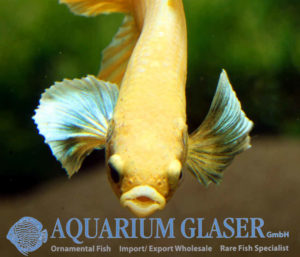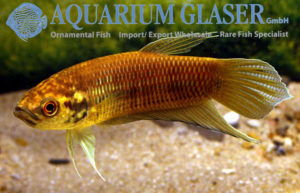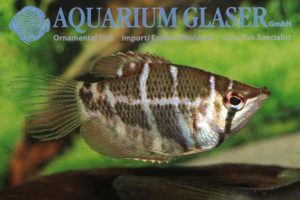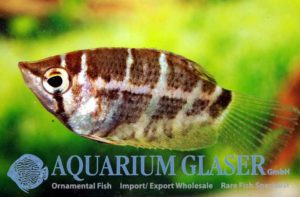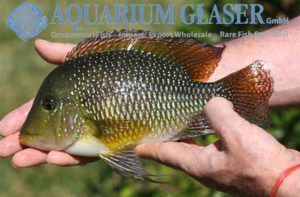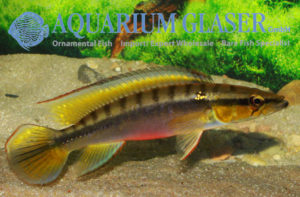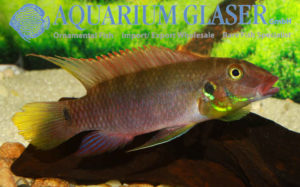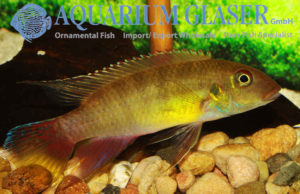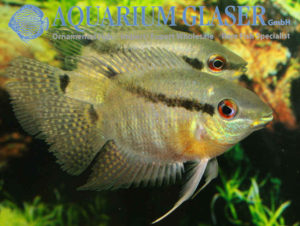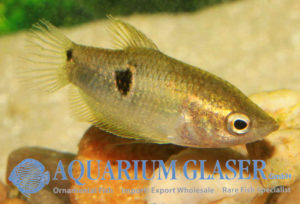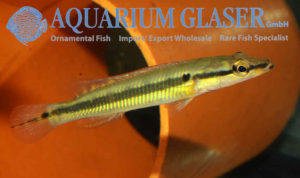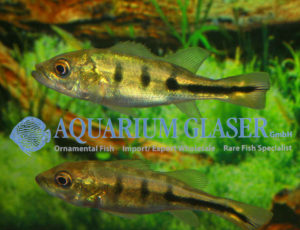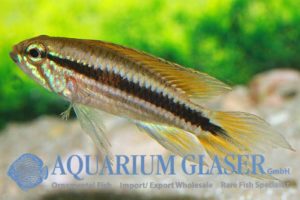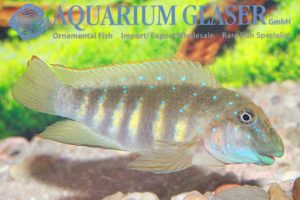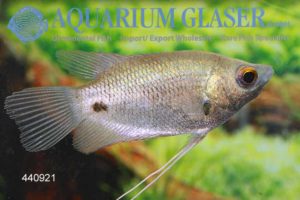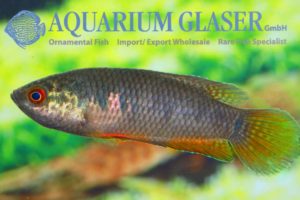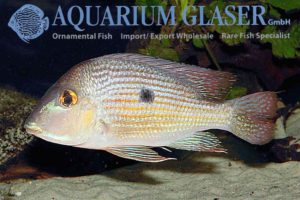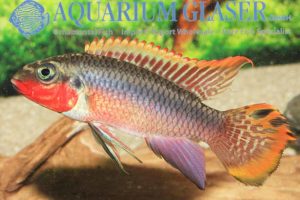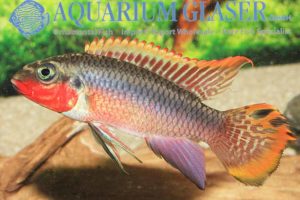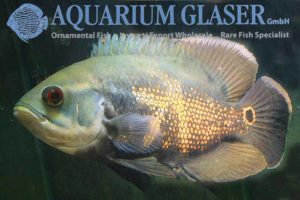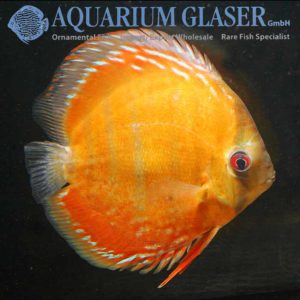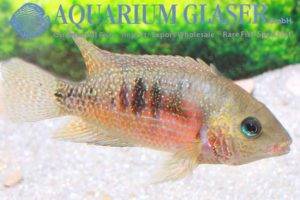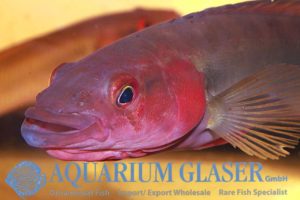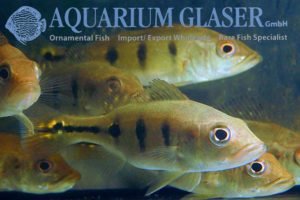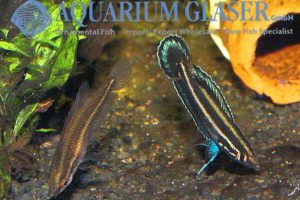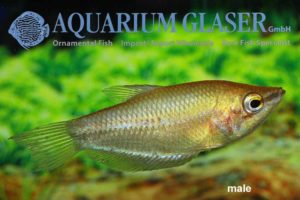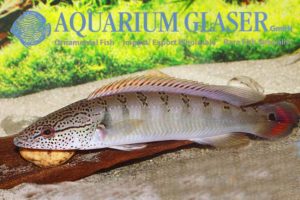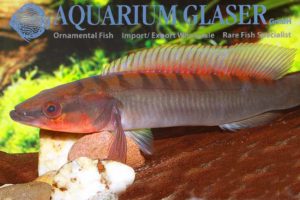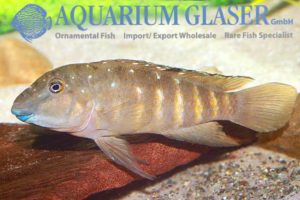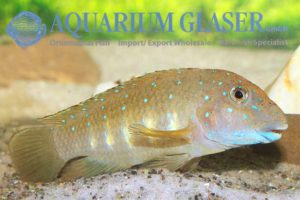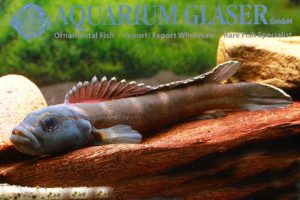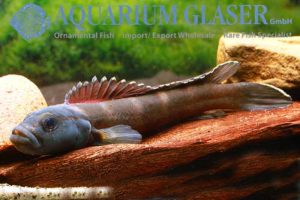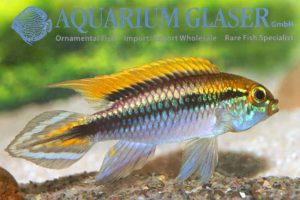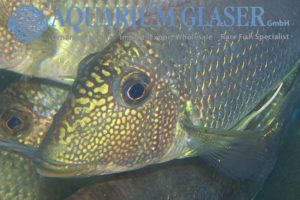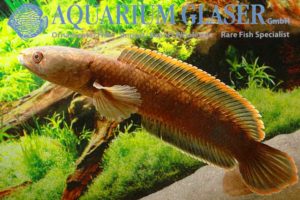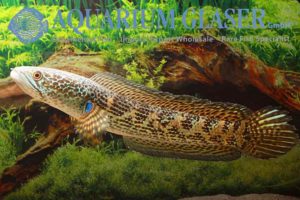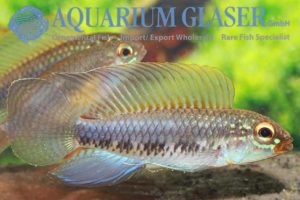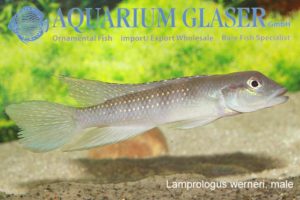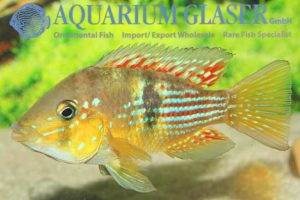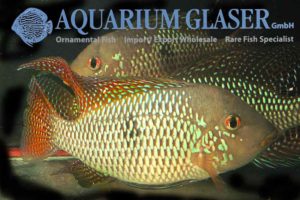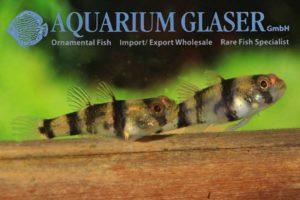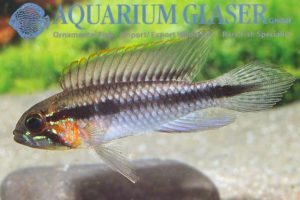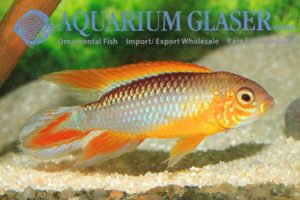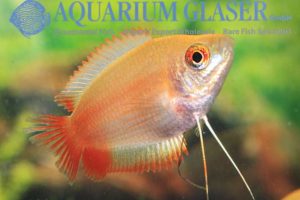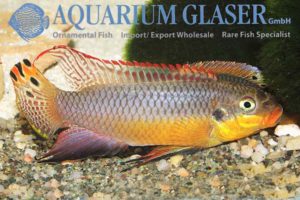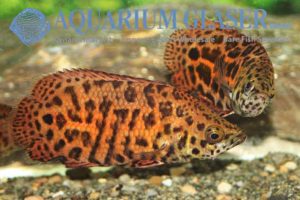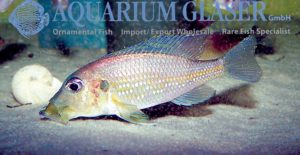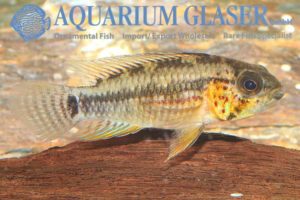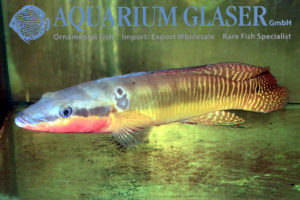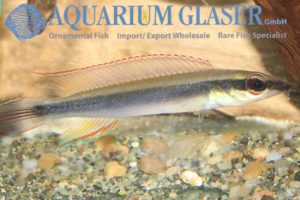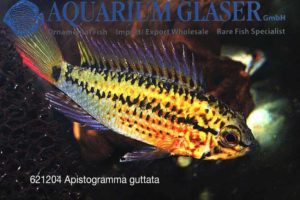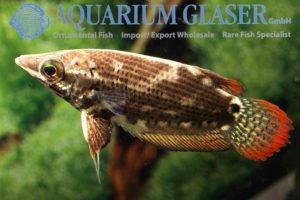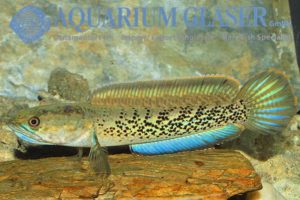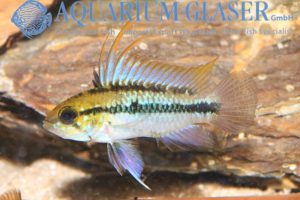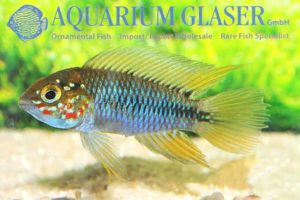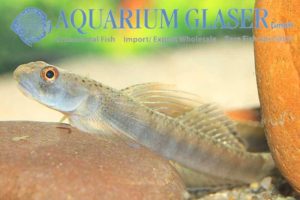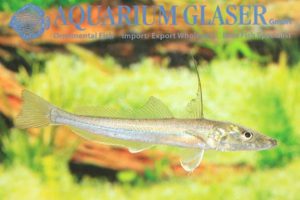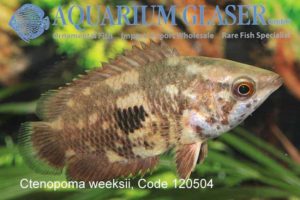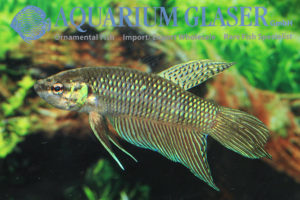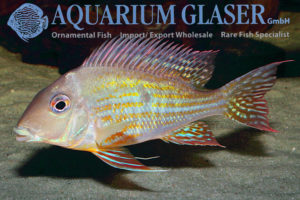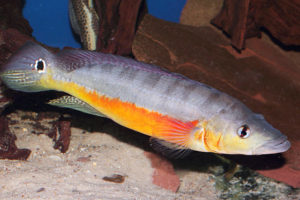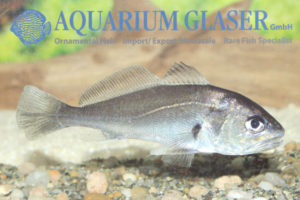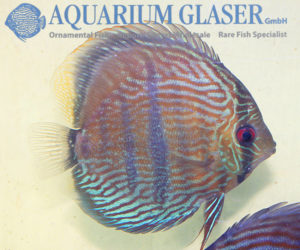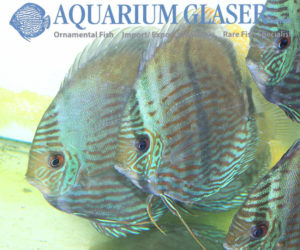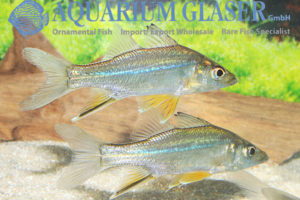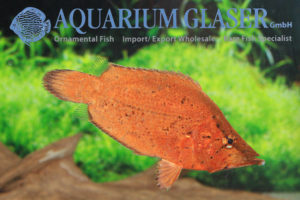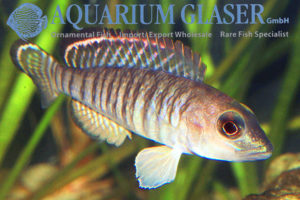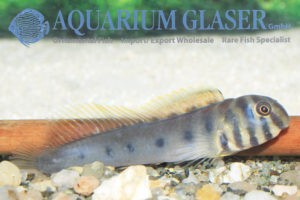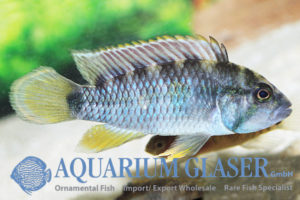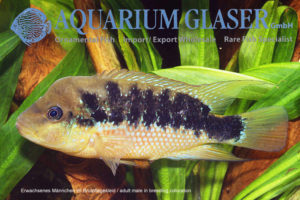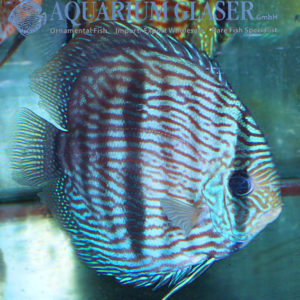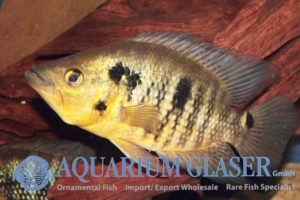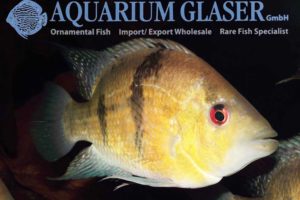Once more we were able to import this beautiful eartheater from the Rio Caete in the northeastern part of Brazil. The species is not described scientifically yet, but belongs without any doubt in the close relationship of the species Geophagus parnaibae and G. sp. “Pindare”. In all probability G. sp. Rio Caete attains a similar […]
25. Perchlike fishes (917)
-
-
Cyphotilapia frontosa “Black Widow”
We received very nice specimens of this rare mutant of the Lake Tanganjika Humphead, which occured around the year 2004 for the first time. Our fish have a size of 7-8 cm. For our customers: the animals have code 517243 on our stocklist. Please note that we esclusively supply the wholesale trade. Text & photo: […]
-
Apistogramma sp. BOLIVIA GOLD
The shipment from the Madre de Dios region in Bolivia also contained a pretty new species of Apistogramma. The fish is without any doubt a close relative of A. luelingi. Due to its bright yellow coloration we provisionally named it “Bolivia Gold”. Our largest males have a length of about 4 cm, the females are […]
-
Rocio octofasciata CHIAPAS
We received German bred F1-generation specimens of wild collected Jack Dempsey cichlids with collecting data. The fish is also known in elder literature under the names of Cichlasoma octofasciatum or C. biocellatum. Available for the first time ever, usually only old aquarium strains with unknown origin are traded. For our customers: the fish have code […]
-
Acentrogobius globiceps
We were able to import once more this nice, only very occasionally available goby from India. The species becomes only 5-7 cm long. A slight addition of seasalt (one spoonful per 10 litres of water) is quite beneficial for the fish. The determination is only preliminary due to the complicated situation in gobies; the fish […]
-
Etroplus canarensis
Only three kinds of cichlids are found in Asia, all of them belong to the species Etroplus. But many scientists believe that Etroplus are closer to damsels than to cichlids. However, all three kinds are marvelous aquarium fish. Two of them, E.macultus and E. suratensis are wide spread. There was no trace of E. canarensis […]
-
Etroplus canarensis
Finally we are able to offer once more the extremely rare and extraordinary beautiful Indian Wasp Cichlid. In contrast to its relatives, this species is an inhabitant of pure freshwater only and never enters brackish water zones. Available in limited numbers only! For our customers: the fish have code 415751 on our stocklist. Please note […]
-
Retroculus lapidifer (2)
The species belonging to the genus Retroculus – currently three species are described scientifically, one additional species is still undescribed – have ever been extremely rarities in the aquarium hobby. Finally we are able to offer once more the beautiful Retroculus lapidifer from Brazil. The fish have ideal sizes (3-6 cm and 6-8 cm), but […]
-
Apistogramma megaptera
This dwarf cichlid has been described finally scientifically under the name of A. megaptera. It is known in the aquarium hobby for decades already under the name of Apistogramma sp. “Breitbinden”. The German word “Breitbinden” means “broad band”. This refers to the broad dark band under the eye. Currently we have wonderful wild collected specimens […]
-
Pelvicachromis taeniatus Nigeria Red
Just in: fantastic German bred specimens of this dwarf cichlid. The fish are in top condition and have a perfect size. For our customers: the fish have code 562303 on our stocklist. Please note that we exclusively supply the wholesale trade. Text & photo: Frank Schäfer
-
Blue Dempsey original strain Argentina!
We managed to import a small number of the original strain of that breathtaking cichlid from Argentina. Although the fish are still very young (3-5 cm) they show already wonderful colours. Available in very limited numbers only! For our customers: the fish have code 657022 on our stocklist. Please note that we exclusiely supply the […]
-
Betta splendens SHORTFIN ELEPHANT EAR
This new type of Siamese fighter is a real dream! The fish reached us currently from Thailand. The name “Elephat Ear” refers to the coloured pectoral fins, which are the typical character of that sport. Available in limited numbers only! For our customers: the fish have code 390643 on our stocklist. Please note that we […]
-
Betta pi
We received a small number of this very rare, mouthbrooding fighting fish from Thailand. The peaceful species becomes ablout 9 cm long. For our customers: the fish have code 386903 on our stocklist. Please note that we exclusively supply the wholesale trade. Text & photos: Frank Schäfer
-
Sphaerichthys selatanensis
With an overall length of 5 cm Sphaerichthys selatanensis is probably the smallest representative of the chocolate gouramis. It may recognized by its typical cross design. The species originates from Kalimantan in the southeast part of the island of Borneo. Like its relatives it lives in acidic black water brooks (at the discovery site measured […]
-
Sphaerichthys selatanensis
We received beautiful, half-grown crossband-chocolate gouramis. The animals are very healthy! For our customers: the fish have code 455822 on our stocklist. Please note that we exclusively supply the wholesale trade. Text & photo: Frank Schäfer
-
Geophagus brasiliensis MOGE / Uruguay
We received beautiful, very healthy German bred G. brasiliensis. The animals belong to a population from Uruguay and represent the first tank raised generation. The breeder provided to us photographs of the parents, which were taken immediately after collecting in Moge. The pictures show how splendid the fish will look like when they are grown […]
-
Crenicichla sp. VENTUARI
We received this extremely rare species from Venezuela. The fish is a comparatively small (maximum length observed so far is 16 cm), very colorful member of the Crenicichla-saxatilis-group. Available in very limited numbers only! For our customers: the fish have code 673053 on our stocklist. Please note that we exclusively supply the wholesale trade. Text […]
-
Pelvicachromis rubrolabiatus FALSADE
This is another, very nice dwarf cichlid from western Africa, available even with the name of the collecting site. We have fully grown and wonderful coloured specimens in stock. For our customers: the fish have code 560363 on our stocklist. Please note that we exclusively supply the wholesale trade. Available in very limited numbers only! […]
-
Pelvicachromis humilis LIBERIA RED
This beautiful sport of P. humilis is available only very occassionally. We received them in an ideal size (5-8 cm). They have already very nice colours! For our customers: the fish have code 559554 on our stocklist. Please note that we exclusively supply the wholesale trade. Available in limited numbers only! Lexikon: Pelvicachromis: the Latin […]
-
Mesonauta mirificus
For the first time ever we can offer these extraordinary nice flag cichlids as German bred (F1). The species originates from Peru. Available in limited numbers only! For our customers: the fish have code 683361 on our stocklist. Please note that we exclusively supply the wholesale trade. Text & photos: Frank Schäfer
-
Parasphaerichthys ocellatus
This extreme rarely imported species originates from Burma. The charming fish attains a length of only 2-3 cm. This is the only species of anabantoid fish whose way of reproduction is still unknown. The only other member of the genus, P. lineatus (see http://www.aquariumglaser.de/en/parasphaerichtys-lineatus_de_1211.html) is a bubblenest builder although the eggs look like the eggs […]
-
Crenicichla zebrina
For the first time ever we could import juveniles of this very rare species. For more information, please check: http://www.aquariumglaser.de/en/archiv.php?news_id=345
-
Cichla orinocensis
We currently have this amazing large cichlid in good numbers and an ideal size in stock. The specimens orginate from Venezuela and most of them are 3-5 cm long. This is a perfect size for the acclimatization of these fish in home aquaria. Besides this we also have a few specimens 5-7 cm long in […]
-
Apistogramma mendezi WILD
Currently we have this very rare dwarf cichlid in super condition and size in stock. Only available in limited numbers! For our customers: the fish have code 624812 on our stocklist. Please note that we exclusively supply the wholesale trade. Text & photos: Frank Schäfer
-
Eretmodus cyanostictus MOBA
We have received a very limited number of wild collected specimens of this splendid cichlid from Lake Tanganyika. The colour variety from Moba (D. R. Congo) is one of the most beautiful sports of this species. For our customers: the fish have code 520502 on our stocklist. Please note that we exclusively supply the wholesale […]
-
Osphronemus laticlavius
We received the very rare red finned giant gourami in two sizes, 4-6 cm (code 440921 on our stocklist) and 8-10 cm (code 440923). The species attains a similar size as the common giant gourami, eg 60 cm. O. laticlavius originates from Borneo. Fertile males develope a very prominent head structure and deep red fins […]
-
Pseudosphromenus cupanus
We received beautiful Black Piketails from the south of India which have a lot of red colours. For our customers: the fish have code 446503 on our stocklist. Please note that we exclusively supply the wholesale trade. Text & photos: Frank Schäfer
-
Geophagus sp. Gurupi
We received beautiful bred specimes from Thomas Weidner, who published this Geophagus in the German magazine “Amazonas” No 36 (July/August 2011) on page 76 for the first time. The photo of the juveniles shows the fish we currently have in stock, the photos of the adults depict the breeders. For our customers: the fish have […]
-
Pelvicachromis taeniatus “Nigeria Red”
Dwarf cichlids from western Africa are bit out of fashion currently. Nobody knows a real good reason why, as usual in fashion. However, anyone who sees the gorgeous Pelvicachromis taeniatus “Nigeria Red” we can offer right now as German bred ones, will become crazy for a new fashion immediately and place a tank with these […]
-
Pelvicachromis taeniatus “Nigeria Red”
Once more we have obtained a very limited number of superb, large, German bred specimens of this wonderful cichlid. For our customers: the animals have code 562304 on our stocklist. Please note that we exclusively supply the wholesale trade. Text & photos: Frank Schäfer
-
Astronotus ocellatus WILD
We currently have some large wild collected oscars from Colombia in stock. Although oscars are always available as bred ones, wild collected ones belong to the real rarities in the market. For our customers: the fish have code 632508 on our stocklist. Please note that we exclusively supply the wholesale trade. Text & photos: Frank […]
-
Discus Red Maues / Lago Paraconi
Divine discus of this variety which have a very high degree of red coloration reached us recently. For our customers: the fish have code 739036 on our stocklist. Please note that we exclusively supply the wholesale trade. Text & photos: Frank Schäfer
-
Neetroplus panamensis, variety RED
We have received wonderful German bred specimens of this relative small, very colorful and extreme rarely offered cichlid. Males become around 13 cm long, females stay smaller. According to the latest systematic revision the fish is placed now in the genus Cryptoheros, subgenus Panamius. For our customers: the fish have code 684602 on our stocklist. […]
-
Pelvicachromis signatus
We recently received this beautiful dwarf cichlid from Guinea. The species is a close relative of P. humilis and was known in the hobby as P. sp. “Bandi 1” before its scientific description. Maximum size in males is around 10 cm, females stay always smaller. As in almost all Pelvicachromis there is an extreme sexual […]
-
Crenicichla cf. lugubris RED ATABAPO
At least we managed to import a small number of one of the most beautiful pike cichlids at all. Breeding fish become deep red all over the body, and even outside the breeding season the fish are spectacular. For our customers: the animals have code 670715 on our stocklist. Please note that we exclusively supply […]
-
Cichla kelberi
For the first time ever we have Cichla kelberi in stock, a species that was only recognized in 2006. The fish is available only in a very limited number. The species is distinguished from its closest relative, C. monoculus, by the presence of light spots in the pelvic fins, the anal fin and the lower […]
-
Crenicichla lugubris ORINOCO
We received beautiful Crenicichla lugubris from Venezuela in three sizes. It is astonishing how drastically these fishes change their coloration during their onotgenesis. Juveniles that show the typical “French fries pattern” are schooling fish that feel very unsafe when kept alone. Then the fish come in the age of puberty. Now they see congeneers only […]
-
Parosphromenus cf bintan SINTANG
The charming licorice gouramis are ideal inhabitants of nano tanks. They can not compare with other fish and so they settle even in nature extreme habitats. The water there is very poor in nutrients, very soft and acidic. These dwarfs among the anabantoids become astoundingly old and can easily reach an age of 5 or […]
-
Sphaerichthys acrostoma
Currently we have the rarest species of chocolate gourami in stock, the Golden Choco-Gourami. This is the largest of all species of Sphaerichthys, maximum length is around 6 cm. Keeping and breeding this species – it originates from Borneo – is comparable to that of S. vaillanti (http://www.aquariumglaser.de/en/sphaerichthys-vaillanti-_de_756.html) Text & Photos: Frank Schäfer
-
Crenicichla sp. Atabapo
Code 672534
-
Crenicichla lenticulata
Code 670005
-
Crenicichla johanna Puerto Inirida
-
Tanganicodus irsacae “Ikola”
Code 576002
-
Eretmodus cyanostictus “Kavala”
Code 520502
-
Teleogramma brichardi
Currently we have a limited number of the very rare cichlid Teleogramma brichardi from the Congo in stock. For our customers: the fish have code 576303 on our stocklist. Please note that we exclusively supply the wholesale trade.
-
Teleogramma brichardi
Currently we have a limited number of the very rare cichlid Teleogramma brichardi from the Congo in stock. For our customers: the fish have code 576303 on our stocklist. Please note that we exclusively supply the wholesale trade.
-
Apistogramma agassizii Flamenco
Currently we received one of the most beatiful varieties of Apistogramma agassizii in limited numbers. The variety “Flamenco” is collected in the wild, but according to our exporter it does not represent a local population. The Flamenco variety is selected from other “normal” Apistogramma agassizii catches. It is well known that under aquarium conditions it […]
-
Satanoperca mapiritensis
We obtained this wonderful, glittering eartheater from Venezuela. The size is 15-18 cm. Members of the genus Satanoperca are also called “devilfishes”, but despite this horrible name the fish are extremely peaceful. They live over sandy bottoms which they browse through in search for food. In such a habitat it makes no sense to defend […]
-
Channa sp. Laos Fireback
For the first time ever we received this splendid snakehead, which obviously represents a species unknown to science so far. I reminds one strongly to the far spread and variety rich species C. gachua, but the “Fireback” is much bigger, reaching 15 -20 cm, it lacks the stripes in the pectoral fins, which are so […]
-
Tropheus sp. Yellow
Currently we have extreme beautiful Tropheus sp. “Yellow” in stock which already display bright colours when young! For our customers: the fish have code 586302 on our stocklist. Please note that w exclusively supply the wholesale trade.
-
Channa aurantimaculata
Just in: one of the most beautiful of all species of snakehead, available only in limited numbers. Size up to 40 cm, our fish currently are 20-25 cm long. For our customers: the fish have code 409014 on our stocklist. Please note that w exclusively supply the wholesale trade.
-
Apistogramma iniridae
Sadly this beautiful dwarf cichlid is only occasionally available, but currently we were able to import once more beautiful, fully grown specimens. The fish are very stable and display all the behaviour that makes the keeping of these fish so desirable. Like its close relative A. uaupesi, which differs from A. iniridae mainly due to […]
-
Lamprologus werneri
Most hobbyists think about the cichlids of Lake Tanganyika when they hear the generic name Lamprologus. But there do exist also some species of river-dwelling (= riverine) Lamprologus. The most attractive species among them is without any doubt Lamprologus werneri, which we were able to import now once more. The slender fish is spread all […]
-
Gymnogeophagus meridionalis
Currently we have magnificent (German pond bred!) specimes of that cichlid, which is almost a dwarf cichlid (our fish are between 5-7 cm long and fully mature and in colour) in stock. There is still no agreement among the specialized aquarists, if this form represents a population of Gymnogeophagus meridionalis, G. rhabdotus or if the […]
-
Geophagus iporangensis
There are more exotic fishes that can be kept and bred at least seasonally in garden ponds than most aquarists think of. Among these species are for sure the different types of Brazilian Pearl Cichlids, the Geophagus-brasiliensis-complex. The group is only poorly understood scientifically, but who cares for names if one looks at these glorious […]
-
Brachygobius aggregatus – one of the smallest fishes of the World
All species of bumblebee gobies (Brachygobius) are small or very small fishes. The debate which is the smallest fish of the world (and coincidently the smallest vertebrate of the world) is still going on; however, it is quite difficult to decide, whether it makes sense to debate about differences of tenth of millimeters in live […]
-
Apistogramma gephyra
This pretty blackwater Apistogramma is imported only very occasionally. Now we were able to manage one of these rare imports again. The fish originates from Brazil where it is found in the central Rio Negro and lower Rio Branco basins. A. gephyra looks quite similar to A. agassizii and its aquarium maintenance is comparable to […]
-
Apistogramma agassizii FIRE-RED
Currently we have wonderful, fully grown specimens of this marvelous sport in stock, originating from German breeders. The fish literally seem to glow from inside! It is very interesting that the typical polychromatism that can be observed in wild populations of this dwarf cichlid is also found in this artificial sport. Polychromatism means that coloration […]
-
Colisa chuna “Fire” – A new sport of the honey gourami
Currently we received this extremely cute new sport of the honey gourami from Singapore. The honey gourami is the smallest known species of Colisa and becomes only 3-5 cm long. The new variety has the yellow-golden body of the well known “Gold”-variety of Colisa chuna, but the tail, the caudal fin and the soft parts […]
-
Pelvicachromis taeniatus Nigeria Yellow
This is another, extreme beautiful variety of that gorgeous dwarf cichlid from Western Africa: Pelvicachromis taeniatus “Nigeria Yellow”. Initially the animal originates from the surroundings of the Nigerian city of Lagos, but we have in stock fully grown adult bred ones. The bright golden breast and the very long finnage make Pelvicachromis taeniatus “Nigeria Yellow” […]
-
Ctenopoma acutirostre wild
It is been a quite long time since we had the last importation of this bushfish from the D. R. Congo. Immediately after their arrival the animals had an unbelievable strong coloration. Sadly it bleached out a bit over the time, but still looks great. Read more about the leopard bushfish here: http://www.aquariumglaser.de/en/archiv.php?news_id=140 For our […]
-
Gnathochromis permaxillaris arrived
This week we received bred specimens of this very rare cichlid from Lake Tanganjika. A breeding report can be found at http://www.aqualog.de/news/web3/3-7.pdf For our customers: the fish has code 520703 on our stocklist. Please note that we exclusively supply the wholesale trade. Lexicon: Gnathochromis: ancient Greek, means “jaw-chromis”, referring to the very special mouth structure. […]
-
Apistogramma sp. Assurini
Currently we received a new Apistogramma from Brazil, a close relative of the species known as A. sp. Xingu in the hobby. Like most Apistogramma, A. sp. Xingu, which has been imported in 1988 for the first time, has developed a number of varieties. Some of them appear within one population, others seem to represent […]
-
First import! Crenicichla zebrina arrived
This pike cichlid was discovered only in 2002 and described scientifically in 2008. It originates from the lower Ventuari river, the largest tributary of the upper Orinoco in Venezuela. The Ventuari is a clearwater river. Although the Ventuari river is rather good sampled, the describers of that unique species were not able to obtain more […]
-
Crenicichla cf. regani Orinoco
The pike cichlids (Crenicichla) are one of the world´s most specious genera of cichlid. Currently 85 species are accepted. Many of them grow larger than 20 cm but there are also dwarf species. The beautiful, slender Crenicichla regani, which is said in literature to grow to a maximum size of 15 cm (male) or 8 […]
-
Apistogramma guttata
Code: 621204
-
Ctenops nobilis
Chocolate gouramis are very beautiful, but demanding anabantoids. Thus they should be kept by experienced aquarists only. There are three genera of chocolate gourami, Sphaerichthys (four species), Parasphaerichthys (two species) and Ctenops (monotypical). The only species in Ctenops is nobilis, the Noble gourami from India. It represents the largest of all chocolate gouramis and can […]
-
Channa stewartii
Code: 409304
-
Apistogramma trifasciata
In case this dwarf cichlid would not exist it would be necessary to invent it for the aquarium hobby. Apistogramma trifasciata is an ideal aquarium inhabitant. The species stays small – males around 5 cm, females around 4 cm. It is completely undemanding regarding water chemistry – keeping and breeding is possible even in medium […]
-
Apistogramma borellii
Recently we received beautiful wild collected specimens of A. borellii from Paraguay. This species is an ideal aquarium fish. In contrast to many other species of the genus A. borellii is completely undemanding regarding water chemistry. Even in medium hard, slightly alcalic water the species thrives well and even breeds. The behaviour of A. borelli […]
-
Stiphodon sp. Spotted Head
Code: 456043
-
Sillaginopsis panijus
The difference between “foodfish” and “ornamental fish” is often hard to tell. For example, who in Europe would term the zebra barb (Danio rerio) a foodfish? Nevertheless hundreds of thousands of these tiny animals are collected daily in India, become dried and are sold as a spice. On the other hand young examples of attractive […]
-
Ctenopoma weeksii
For our customers: the fish have code 120504 on our stocklist.
-
Betta mahachaiensis
Code number: 377103 Photo: Frank Schäfer
-
Geophagus altifrons “Alenquer”
Code number: 675003 Photos: Thomas Weidner
-
Crenicichla vittata
Code number: 673612 Photos: Thomas Weidner
-
Plagioscion squamosissimus
Croakers, also called Drums (Sciaenidae) are a fish family that comprises about 290 species. Most of them are marine, but some occur exclusively in fresh water. In South America about 20 species and 4 genera are known to live in fresh water. The smallest among them becomes only 7 cm long (Pachypops pigmaeus), most become […]
-
Discus Heckel Cross
The term “discus Heckel cross” is given for fish with a broader central bar on the body, the so called “Heckel bar”. Despite this the fish are very different and probably also originate from different regions. Among them are real gems, some with a high degree of red body colouration. For our customers: the fish […]
-
Discus Heckel Blue Body Nhamunda
Currently we have beautiful, large Heckel discus from the Rio Nhamunda in stock. The characteristic feature of that variety is the bright blue sash-like band. For our customers: the fish have code 734095 on our stocklist. Please note that we exclusively supply the wholesale trade. Text & photo: Frank Schäfer
-
Centropomus unionensis
The snooks (Centropomus) are distributed in the New World; currently 12 species are recognized. Persons that are reminiscent of giant perches (Lates) by looking at snooks are not wrong: until quite recently the snooks and the giant perches were united in a single family, Centropomidae. We were now able to import a pretty species of […]
-
Monocirrhus polyacanthus
The Leaffish, Monocirrhus polyacanthus, belongs to the most astonishing species of freshwater fish at all. The species – the genus Monocirrhus is monotypical – is spread all over the Amazon basin. It is found in Bolivia, Brazil, Colombia, Peru, and Venezuela. Our imports usually come from Peru, so the current one does. The Leaffish belongs […]
-
Lamprologus signatus
This beautiful cichlid from Lake Tanganyika belongs to the dwarf cichlids. Males become around 5.5 cm, females around 3.5 cm long. At the first glimpse one would think that these tiny fish are “snail brooders”, e.g. that the females would spawn only in empty snail shells. However, this is not true. In their natural habitat […]
-
Omobranchus zebra
Omobranchus belongs to the Blenniidae family, most of which live in marine environments. Due to their funny behaviour and the generally easy keeping the blennies are favorite fish of the marine hobbyists. There are only very few species that settle permanently in fresh or brackish water. One of the latter is the pretty Omobranchus zebra, […]
-
Apistogramma panduro var. “Marsel”
We were able to import this new dwarf cichlid from Peru now. The fish is without any doubt a close relative of the species Apistogramma nijsseni, A. panduro and the still undescribed A. sp. “Inka II”. In contrast to these species the seam around the caudal fin in males is yellow instaed of red-orange. The […]
-
Cichlasoma istlanum
The large cichlids from Central America are a bit out of fashion currently. That is a sad thing, for hardly any other fish combines in such a perfect matter brillant coloration, personality and interesting behaviour. Of course these fish need large tanks and an equipment that fits their needs, but if these things are given […]
-
Discus champions on a visit
Once more our Japanese friend Mr Akira Ishinabe has placed his discus he displayed in the current discus championship in Duisburg in our facility to give them an opportuntity to rest a bit after the stress of the exhibition before they turn back home to Japan. His Green Wild was able to get the first […]
-
Caquetaia kraussii
In the wild, Caquataia kraussii is something like a million fish. There is literally no waterbody, may it be pond, lake, or river in the Llanos of Venezuela without this cichlid. So the cichlid enthusiast is a bit left alone with the question why it takes so long if one searches for this fish in […]
-
Caquetaia myersi
Caquetaia myersi belongs definetly to the real rarities in the aquaria of the world. The main reason for this is the fact that it occurs in the wild far from the usual collecting sites in Colombia. What makes fishing in those areas even more difficult is the presence of guerilla which has quite different interests […]
Blue Dempsey Cichlids German Bred arrived

We received very nice German bred specimens of this breathtaking cichlid. For more information on the species please click here: http://www.aquariumglaser.de/en/fish-archive/southamerican-cichlids-en/_en-4/

For our customers: the fish have code 657132 on our stocklist. Please note that we exclusively supply the wholesale trade.
Text & photos: Frank Schäfer
Scalare Red Devil

Once more we received a wonderful consignment of this attractive sport of the Angel. This time the fish are even more red than usual.
For our customers: the fish have code 697562 on or stocklist. Please note that we exclusively supply the wholesale trade.
Text & photo: Frank Schäfer
Wild Rams

Due to the regularly offered, amazing bred sports of the Ram (Mikrogeophagus ramirezi) one tends to forget, how breathtaking beautiful the wild collected fish is already. Currently we have fully grown, wild collected Rams from Venezuela in stock. By the way: wild collected Rams become only about 5 cm long (in males), females even stay smaller, so this species is definitely a dwarf cichlid!


For our customers: the animals have code 686515 on our stocklist. Please note that we exclusively supply the wholesale trade.
Text & photos: Frank Schäfer
Rams Jumbo Gold

We received Rams “Gold” in showsize from our proved breeder. Available in limited numbers only!

For our customers: the fish have code 686805 on our stocklist. Please note that we exclusively supply the wholesale trade.

Text & photos: Frank Schäfer
A brandnew dwarf cichlid! Apistogramma sp. Cristal

A completely new species of Apistogramma reached us recently from Peru. It was named “Apistogramma Cristal” by the exporter. However, this name has no scientific value at all. Available in very limited numbers only!

For our customers: the fish have code 618104 on our stocklist. Please note that we exclusively supply the wholesale trade.


Text & photos: Frank Schäfer
Many varieties of snakehead currently available at Aquarium Glaser
Currently we have a good number of very interesting and beautiful species of snakeheads in stock.

Channa obscura, placed in the meantime in a different genus, namely Parachanna, originates from Africa. The species attains a length of about 40 cm. Currently we have 4 cm long babies in stock that we received from Nigeria. The fish have code 111002 on our stocklist.
All the other species we have in stock still belong to the genus Channa and originate from Asia.

We received adult Channa gachua from India (Bengal). The species attains a length of 10-15 cm and is a mouthbrooding species. These fish have code 409084 on our stocklist.

For the first time ever we can offer German bred Channa pulchra. This is a medium-sized species (20-30 cm) that originates from Burma. Our specimens are currently 12-15 cm long, show very nice coloration and have code 409245 on our stocklist.

Another Indian species is Channa punctata. That fish is not as colorful as the former, but quite peaceful (compared with other snakeheads) and does not grow very big. Common size in the wild is 15-20 cm. Our specimens come from Bengal and are 8-10 cm long. They have code 409252 on our stocklist.

The species Channa stewartii is found only along the Himalaya in the north of India. Here a lot of different colour varieties are known. The fish we currently have in stock (code 409303) are 10-12 cm long (they may reach up to 25 cm) and have a very nice metallic blue-green basic coloration.

A real dwarf and breathtaking colourful is the Channa sp. 'Dwarf Fire & Ice'.. We have not seen them larger than 12 cm so far. This beauty has code 409363 on our stocklist.


The next two species are real giants that can reach at least 80 cm in length. Angling records are by far larger! Channa diplogramma (code 409153) originates from the south of India and C. micropeltes (code 409204) from Thailand. Both species still show at a size of 10-12 cm their baby-coloration, which is very attractive: broad orange-red stripes along the body. Both species look so similiar at that age that it was thought more than 100 years that both would belong to the same species. However, the adults looks completely different. C. diplogramma becomes creamy white all over the body with black or red dots on the scales. C. micropeltes gets a blue-black back and a silvery belly as adult fish.

Finally, we have another scientifically still undescribed species in stock, which is obviously a close relative of C. gachua: Channa sp. 'Laos Fireback'. It seems that this fish becomes a bit larger than typical C. gachua, but for sure the fish we currently have in stock (code 409394, size 15-20 cm) have reached already maturity.
Please note that we exclusively supply the wholesale trade.
Lexicon: Channa: ancient Greek, means “snapper”, probably referring to the airbreathing. Parachanna: ancient Greek, means “looks like Channa”. obscura: Latin, means “dark”. gachua: after the common name of the species in Bengal. pulchra: Latin, means “beautiful”. punctata: Latin, means “spotted”. stewartii: dedication name for “Major Stewart, Superintendent of Cachar”. diplogramma: ancient Greek, means “with double bands”. micropeltes: ancient Greek, means “with small scales”.
Text & photos: Frank Schäfer
Sunfish special!
Enneacanthus gloriosus

The Bluespotted Sunfish (Enneacanthus gloriosus) is a coldwater fish and a real oldtimer among aquarium fish. Aquarists used to name the up to 7.5 cm long fish “working class discus”, due to its brillant colours and the nice behaviour. However, it was never as expensive as the discus.
Bluespotted Sunfish occur in nature along the southeastern coastal region of the US. Here they live in ponds and slow moving rivers with clear water and a dense vegetation. In the aquarium they are not undemanding. They need clean, clear and preferably soft and slightly acidic water. Moreover they are said to be very anxious and can die when shocked. Neverless it is not a big problem to fulfill these demands and a tank with Banded Sunfish belongs to the most beautiful looks one can have in the whole aquarium hobby.
Like all sunfish, the Banded Sunfish usually refuses flake food, it is better to feed them on frozen and live food The term “coldwater fish” is often misunderstood. In this case it does not mean that the tank for sunfish has to be cooled in living rooms. These species have no problem with temperatures as high as 26°C for some time. However, they need a cool period during winter at 4-10°C, otherwise they will not breed.
In Central Europe this species will not survive extreme winters in the garden pond, so it is better to bring them in a cool cellar room from December to March.
For our customers: the fish has code 803803 on our stocklist. Please note that we exclusively supply the wholesale trade.
Lexicon: Enneacanthus: ancient Greek, means “with nine spines”. This refers to the structure of the dorsal fin. gloriosus: Latin, means “glorious”.
Common name: Bluespotted sunfish
Text & photo: Frank Schäfer
Enneacanthus chaetodon
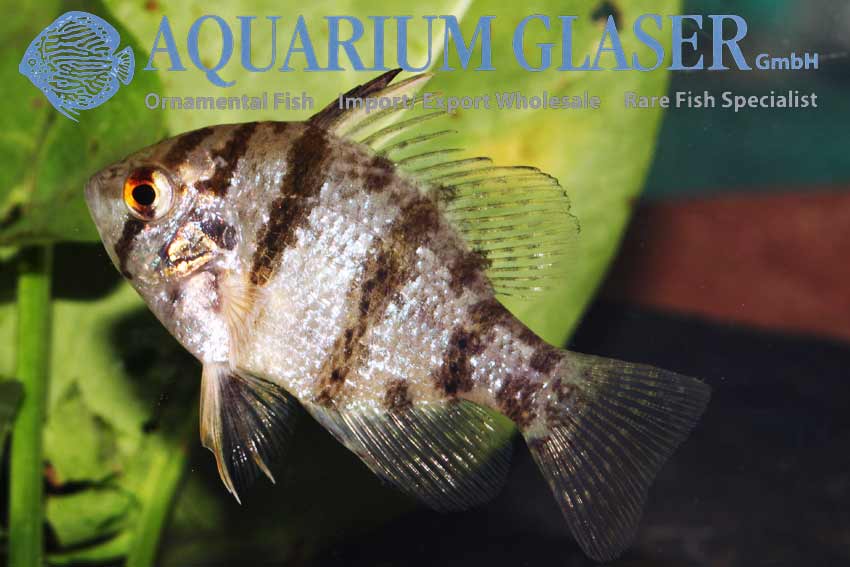
Everything that has been said for the Bluespotted sunfish is also true for the Blackbanded sunfish, E. chaetodon, that also occurs in the wild along with its cousin.
We have received very nice, fully grown German bred ones!
For our customers: the fish have code 803702 on our stocklist. Please note that we exclusively supply the wholesale trade.
Lexicon: chaetodon: ancient Greek, means “with hairlike teeth”
Common name: Blackbanded sunfish
Text & photo: Frank Schäfer
Lepomis gibbosus

The pumpkinseed (Lepomis gibbosus) is one of the most beautiful coldwater fishes. Moreover it has a very interesting behaviour. The species originates from central parts of the North American continent. The continental climate (hot summers, cold winters) makes the pumpkinseed a hardy fish and so it was transferred by humans to many regions as a foodfish.
To Europe it was brought around 1880 for the first time. Since then it became a native fish in Europe but was not able to settle over the whole continent. Nowadays the pumpkinseed is blamed as an unwanted and useless species in Europe. In its natural habitat the fish grows up to 25 cm, but in Europe it stays small. How come? Indigenous North American populations of the pumpkinseed serve as food fish for many predators. The strategy of the pumpkinseed is a a very high reproduction rate. In Europe these predators are missing what leads to a mass-reproduction and the fish stay dwarfish. This phenomenon is also known from other fish species. The perch (Perca fluviatilis) also becomes dwarfish where predators are missing. And so the pumpkinseed usually grows only up to 5-10 cm in Europe.
In aquaria the fish can become much older than in nature. Like all fish the pumpkinseed can grow its whole live through and so aquarium specimens can grow to a captial size. In the garden pond, on the other hand, they usually stay small (around 15 cm). With growing age the adaptability to changes in the enviroment lessenes and so most pumpkinseeds die at the age of around 5 years due to weatherchanges or something similiar. It is wise to buy small individuals (4-5 cm) as their adaptability is high and they easily adopt to live in the new environment.
The garden pond for pumpkinseeds should contain shallow parts with fine sand. Good growth of submerged plants is also important for the fish. Clear and clean water ist preferred. Pumpkinseed are small preators which feed on insect larvae, amphibian larvae, small fish and so on. They can be fed easily with frozen bloodworm, but will almost ever refuse dried food. Males become bigger than the females and are more colourful. A pairbinding is not known in the species, the male will readily mate with any females that will come around. The males defend territories where they take care of the brood until the fry swims free.
For our customers: the animals have code 882500 on our stocklist. Please note that we exclusively supply to the wholesale market.
Lexicon: Lepomis: ancient Greek, means “with scales on the operculum”. gibbosus: Latin, means “humped”
Common name: Common Sunfish, Pumpkinseed
Photo: B. Migge / Aqualog archieves Text: Frank Schäfer
Lepomis cyanellus

This is a close relative of the Pumpkinseed. Lepomis cyanellus, the Green Sunfish, is only very occassionally found in the trade. It differs from L. gibbosus by the much larger mouth. The Green Sunfish also becomes much larger than its cousin, about 30 cm. Thus it represents a beautiful inhabitant for large coldwater aquaria and garden ponds. Our animals are German pond bred and currently 7-9 cm long.
For our customers: the animals have code 882203 on our stocklist. Please note that we exclusively supply the wholesale trade.
Lexicon: cyanellus: Latin, means “blueish”
Common name: Green Sunfish
Text & photo: Frank Schäfer
Centrarchus macropterus

The Flier was a very popular aquarium fish some decades ago; nowadays it is somewhat “out of fashion”. This is very unjustified, as is shown by the wonderful, 8-12 cm long specimens we currently have in stock.
Fliers are calm, majestic fishes that are real eyecatchers for every well planted coldwater aquarium. In the garden pond, these fishes also look extremely beautiful when they stand in shallow water over sandy ground and the sun makes them glitter as if they were powered with gold dust.
Young specimens show a well defined ocellus in the soft part of the dorsal fin which gets lost when the fish gorow to adult ages.
For our customers: the fish have code 803106 on our stocklist. Please note that we exclusively supply the wholesale trade.
Lexicon: Centrarchus: ancient Greek, menas “with spiny back”, referring to the spines of the anal fin. macropterus: ancient Greek, means “with large fins”.
Text & photo: Frank Schäfer
Another brandnew sport of the ram: Super Neon Blue Gold!

We have received another, gorgeous sport of the ram from our German breeder. The fish have sizes of 2.5 – 3.5 cm and are very healthy.

For our customers: the fish have code 686723 on our stocklist. Please note that we exclusively supply the wholesale trade. The new ram is available in limited numbers only!
Text & photos: Frank Schäfer
New in stock: Mikrogeophagus ramirezi Perlmutt / Pearl

This is a brandnew, extreme beautiful sport of the ram. We have them in sizes of 2.5 – 3.5 cm.

For our customers: the fish have code 686733 on our stocklist. Please note that we exclusively supply the wholesale trade.
Text & photos: Frank Schäfer
Available again: Sphaerichthys selatanensis

After a long time we were able again to stock the beautiful Sphaerichthys selatanensis from Borneo.

Read more about the species under: http://www.aquariumglaser.de/en/fish-archive/labyrinthfish-en/Sphaerichthys_selatanensis_en/
A new sport of paradise fish

The paradise fish (Macropodus opercularis) was the first exotic species of ornamental fish at all and is kept and bred continously in aquaria since 1869. Until today it can be considered to be one of the most beautiful and interesting fish. Moreover it is very easy to keep and breed.

There are only very few sports of the paradise fish. The best known is the blue sport which was developed in the 1950ies. Albinos exist much longer already. Only in the 1990ies a stripeless, deep red sport was developed by the breeders of ornamental fish.
For the first time ever we now received stripeless blue fish which have a broad red band on the flanks.

For our customers: the fish have code 425813 on our stocklist. Please note that we exclusively supply the wholesale trade.
Lexicon: Macropodus: ancient Greek, means “with great fins”. opercularis: the term refers to the dark spot on the operculum.
Suggestion of a common name: Blue Flame Paradise Fish; trade name: Paradise Fish “Blue/Red band”
Text & photos: Frank Schäfer
Discus season!
The season for wild collected discus is running now and we can offer a great number of marvellous animals, for example from the Nhamunda-Maracanha region (please, see also http://www.aquariumglaser.de/en/fish-archive/discus-en/Diskus_Nhamunda_rose__en/, http://www.aquariumglaser.de/en/news/Nice_Discus_wildcaught_available__en/, http://www.aquariumglaser.de/en/fish-archive/discus-en/Diskus_Nhamunda_rose_en/ and http://www.aquariumglaser.de/en/news/Discus_Royal_Blue_Nhamunda_Maracanha_en/):

731306 Blue Nhamunda Maracanha

731356 Royal Blue Nhamunda Maracanha

731365 Semi-Royal Blue Nhamunda Maracanha

731405 Rose Nhamunda Maracanha
For the first time we have wonderful Discus Caiambe in stock. Although these are wild collected fish, they cannot be assigned properly to the Green or the Brown/Blue Discus. Some specimens have red dots on the flanks, a phenomenon that can be found in Green discus also.

732505 Caiambe

732505 Caiambe

732515 Caiambe Few Spot
And last but not least we also have pretty discus from the Rio Aripuana in a semi-royal selection and a good size in stock.

735995 Semi-Royal Blue Aripuana
(to be continued)
Text & photos: Frank Schäfer





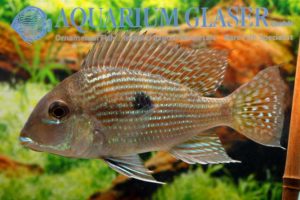
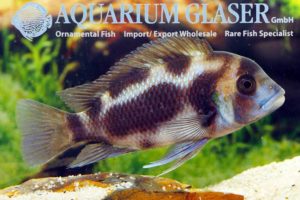
-mann-300x200.jpg)
